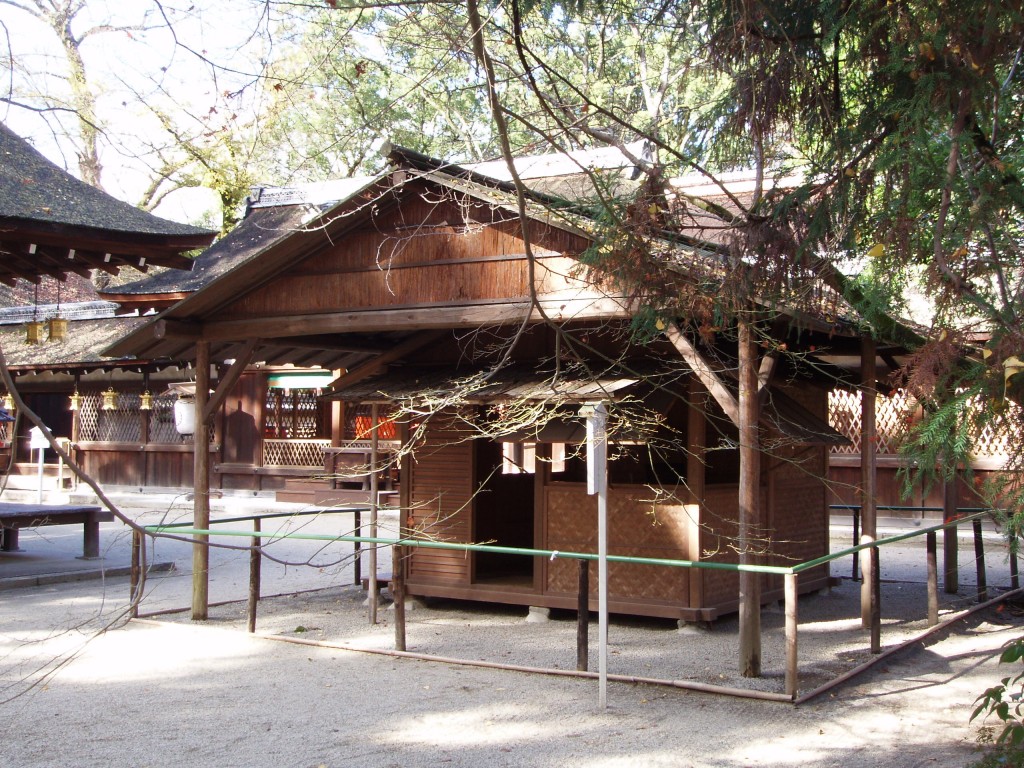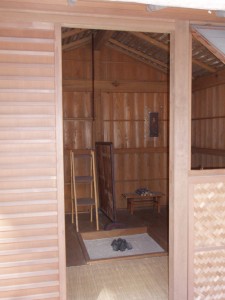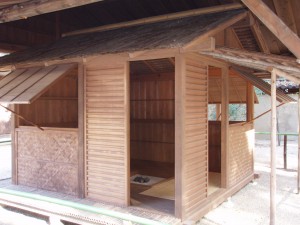
Model of Kamo no Chomei's hut at Kawai Jinja, within Shimogamo Shrine. The hut itself is beneath the large protective roof.
More than 1000 years ago my local shrine, Shimogamo Jinja, used to house a school and museum. By way of commemoration a panel of local academics has been set up to promote the shrine, and their first initiative is a contest on the theme of Hojoki, the thirteenth-century essay by Kamo no Chomei (1153-1216) who was once a priest at the shrine.
Like others of his age, Chomei was syncretic in religious matters. Disillusioned by being passed over for promotion (he expected to take over his father’s position), Chomei became a Buddhist recluse and wrote of his solitary life in the manner of Thoreau’s Walden. The competition being run by the shrine is timed to celebrate the seven hundredth anniversary of the book.

Inside the ten-foot square hut
At the age of fifty Chomei left his family life to dwell in the midst of nature on a hill near Uji. There he built a ten-square foot hut known as Hojoki, a model of which stands in Kawai Jinja, a shrine within the Shimogamo complex. It looks like a glorified summer hut, with a small porch and Heian-style shutters. In summer it was open to the elements, and in winter a fire converted it into a smoky haven.
“It is a hut,” wrote Chomei, “where, perhaps a traveller might spend a single night; it is like the cocoon spun by an aged silkworm. This hut is not even a hundredth the size of the cottage where I spent my middle years… A bare two carts would suffice to carry off the whole house.”
Back to nature
Chomei’s account wanders from topic to topic in the zuihitsu (‘follow your pen’) style and describes his life in the ten-foot square hut. Descriptions of the natural disasters during his lifetime almost beggar belief. Fire, whirlwind, famine and earthquake follow in quick succession. Corpses lie in the streets, and infants suck at the breasts of dead mothers. Thoughts of death are never far from Chomei’s mind, and like Shakespeare he believes that readiness is all. Indeed, the whole seasonal round seems to him one year-long reminder:
“In the spring I see waves of wisteria like purple clouds, bright in the west. In the summer I hear the cuckoo call, promising to guide me on the road to death. In the autumn the voice of the evening insects fill my ears with a sound of lamnetation for this cracked husk of a world. In winter I look with deep emotion on the snow, piling up and melting away like sins and hindrances to salvation.”

The Hojoki model with its shutters and doors open
The author describes his life in appealing terms. It must have been lonely and at times miserable, but he makes it sound idyllic. “The best friends one can have are flowers and moon, strings and pipe,” he says of his solitude.
He uses fresh rainwater for tea and soup, eats home-grown mushrooms, herbs and fruit, and for exercise he wanders to a nearby temple, or makes sorties to places of poetical interest. He plays music too which harmonises with the rhythms of nature. “My body is like a drifting cloud – I ask for nothing, I want nothing. My greatest joy is a quiet nap; my only desire for this life is to see the beauties of the seasons.”
You can’t help liking someone who takes such pleasure in the little things of life. “I seek only tranquility; I ask only for the absence of grief,” he writes. This modest monk even ends his account by wondering if he has not become too attached to his solitary life. “It is a sin for me to love my little hut, and my attachment to solitude may be an obstacle to enlightenment.” Freed from the ‘dust of the world’, Chomei was able to muse on life’s many blessings. The reader is the beneficiary.
************************************************
The photo/essay contest is announced in the current Shimogamo magazine, Mikage, and is open to people of all nationalities. Entries can be photos of the shrine, the Hojoki hut or Tadasu woods. Essays or poems can be on the theme of Kamo or Kamo (Kamo River or Kamo no Chomei). The fee for each entry is Y800, and prizes range from Y10,000 to Y300,000. Details of application can be had from the shrine. Deadline is the end of June, so plenty of time to plan your Shimogamo visit and get creative. Good luck! I’ll be putting in an entry myself so you’ll be competing against me too…
Shimogamo shrine magazine with picture of Kamo no Chomei

Leave a Reply